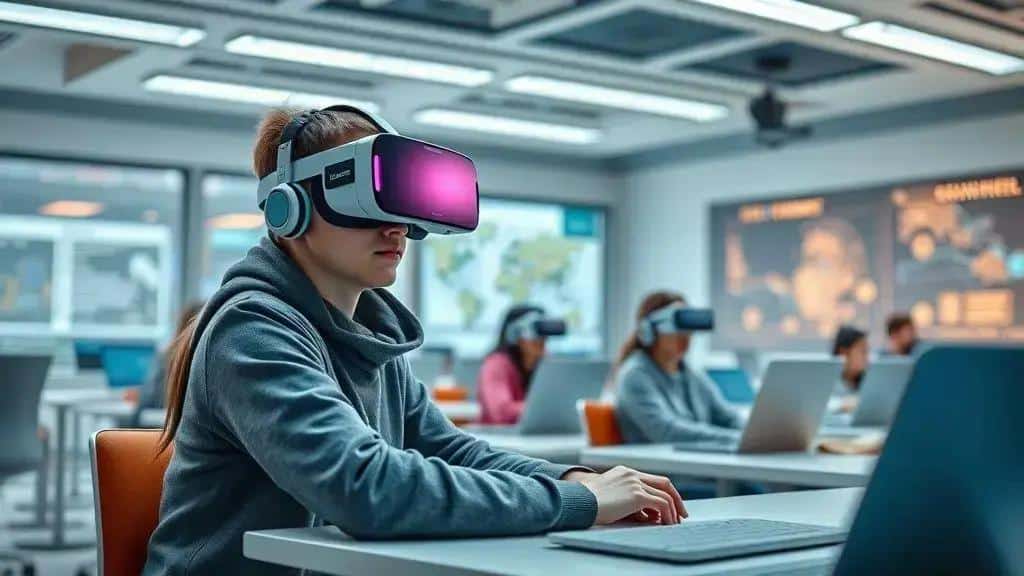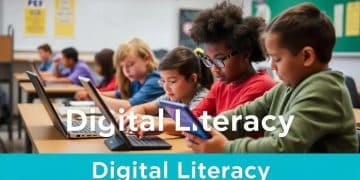Online learning trends in K-12 schools you can’t ignore

Online learning trends in K-12 schools are rapidly evolving with the integration of digital platforms, AI, and flexible learning models that enhance accessibility, engagement, and collaborative opportunities for students.
Online learning trends in K-12 schools are transforming how students and teachers interact. Have you ever wondered how these changes might impact your child’s education? In this article, we will delve into the trends shaping modern learning environments.
The rise of digital platforms in K-12 education
The rise of digital platforms in K-12 education is changing the landscape of how students learn and interact with their teachers. Schools are increasingly embracing technology to enhance the learning experience and meet the needs of today’s learners.
Benefits of Digital Platforms
Digital platforms offer numerous advantages. They create flexible learning environments where students can learn at their own pace. Additionally, these platforms encourage collaboration among peers.
- Accessibility to various learning materials
- Interactive tools for enhanced engagement
- Real-time feedback for improved performance
- Support for diverse learning styles
Moreover, educators can use data from these platforms to tailor instruction and monitor student progress more effectively. This data-driven approach is helping to identify gaps in knowledge and adjust teaching methods accordingly.
Overcoming Challenges
While there are many benefits, challenges such as access to technology and internet disparities remain. Schools must address these concerns to ensure that all students can benefit from digital learning. Innovating methods to provide devices and internet access is essential for equal opportunities in education.
The success of digital platforms also depends on professional development for teachers. Ensuring that educators are well-trained in using technology effectively furthers the goal of enhancing K-12 education.
In conclusion, the integration of digital platforms into K-12 education holds great potential. As we navigate the evolving educational landscape, we can expect these tools to play a central role in fostering an engaging and inclusive learning environment.
Benefits of blended learning models

Blended learning models combine traditional classroom methods with online activities. This approach offers numerous benefits for both students and educators.
Enhanced Flexibility
One major advantage of blended learning is flexibility. Students can access materials and complete assignments at their own pace. This flexibility allows learners to balance their academic responsibilities with other activities.
- Students can revisit lessons as needed
- Different learning pathways accommodate individual paces
- Teachers can offer personalized support based on student progress
Moreover, blended learning encourages greater student engagement. Interactive digital tools keep lessons dynamic and interesting. Engaging with technology often motivates students to take an active role in their education.
Opportunities for Collaboration
Blended learning also fosters collaboration among students. Online platforms facilitate group work and discussions beyond the classroom setting. This connectivity allows peers to share thoughts and ideas easily.
Students learn to communicate effectively in digital spaces, an essential skill for the future. Additionally, teachers can monitor group activities more efficiently, ensuring everyone contributes.
Increased access to resources is another critical benefit of blended learning. Students have more opportunities to explore online libraries, educational videos, and interactive simulations. This access enriches their learning experience and broadens their understanding of various subjects.
Engagement strategies for online learners
Engaging online learners can be challenging. However, employing effective engagement strategies for online learners can significantly enhance their experience and academic performance.
Interactive Content
One effective strategy is using interactive content. This includes quizzes, polls, and multimedia elements. Engaging students with lively content keeps them interested.
- Incorporate videos and animations to explain complex concepts
- Use gamification to motivate learners
- Include opportunity for students to create their own content
Furthermore, interactive discussions can enhance learning. Using breakout sessions and online forums allows students to share ideas and collaborate. This not only builds community but also improves understanding.
Regular Feedback
Providing regular feedback is essential for keeping students motivated. Personalized feedback helps them understand their strengths and areas for improvement. This feedback loop encourages students to take ownership of their learning.
Encouraging peer feedback is another way to enhance engagement. Students learn a lot by evaluating each other’s work. This process develops critical thinking and builds a supportive learning environment.
To further engage students, offer flexible learning paths. Allowing learners to choose topics or project formats caters to their interests, making education more enjoyable. Flexible options can lead to greater commitment and enthusiasm in learning.
Future predictions for virtual classrooms

As we look toward the future, predictions for virtual classrooms suggest significant advancements in technology and teaching methods. These changes are set to transform education, making it more accessible and engaging for students.
Integration of Artificial Intelligence
One major prediction is the increased use of artificial intelligence (AI) in online learning environments. AI will help personalize education by adapting lessons based on individual student needs. For example, AI systems could analyze student performance in real-time, offering tailored resources to help them succeed.
- Customized learning experiences based on real-time data
- Enhanced tutoring through AI-driven platforms
- Automated assessments to save time for teachers
Furthermore, we can expect more immersive learning experiences. Virtual reality (VR) and augmented reality (AR) are likely to play a crucial role in the way students interact with course materials. This technology will allow for hands-on experiences that previously required a physical classroom.
Expanded Global Learning Opportunities
Another important trend is the expansion of global learning opportunities. Virtual classrooms break down geographical barriers, allowing students from different parts of the world to collaborate. This interaction will not only enrich the educational experience but also foster cultural awareness.
Moreover, institutions will likely offer hybrid models that combine in-person and online classes. This flexibility will cater to diverse learning preferences, making education more accessible to everyone. Students will benefit from various methods and resources, enhancing their overall learning experience.
In summary, the future of virtual classrooms appears bright and full of innovation. As technology continues to evolve, educators will seek new ways to engage students and improve learning outcomes.
In conclusion, the landscape of education is evolving rapidly with the integration of digital technologies. As we embrace the future of virtual classrooms, there are exciting opportunities to enhance learning experiences, foster collaboration, and engage students. By leveraging tools such as AI, VR, and global connectivity, educators can create dynamic and inclusive classrooms that meet the diverse needs of all learners. The potential for growth in online learning is immense, paving the way for more accessible, interactive, and personalized education for everyone.
FAQ – Frequently Asked Questions about Virtual Classrooms
What are virtual classrooms?
Virtual classrooms are online learning environments where students and teachers interact through digital platforms, enhancing accessibility and engagement.
How can AI improve virtual learning?
AI can personalize education by tailoring lessons to individual student needs and providing real-time feedback to enhance learning outcomes.
What are some benefits of blended learning models?
Blended learning models combine online and in-person teaching, offering flexibility and catering to diverse learning preferences while promoting engagement.
How can I enhance student engagement in online learning?
Using interactive content, regular feedback, and opportunities for collaboration can significantly boost student engagement in online learning settings.





